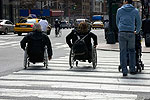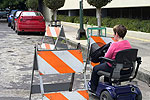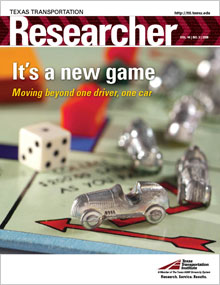 It’s a nice day for a stroll. You head out the door and hit the sidewalk. But wait—someone’s doing construction and has torn up the sidewalk. How do you safely navigate around the work zone? Do you walk in the street? Do you cross the road to use the other sidewalk, if there is one? Do you take a detour? Now imagine you’re in a wheelchair or your vision’s impaired. Imagine you have no vehicle and that walking is your only means of getting to the grocery store or office. Navigating that work zone safely isn’t optional, and it isn’t easy.
It’s a nice day for a stroll. You head out the door and hit the sidewalk. But wait—someone’s doing construction and has torn up the sidewalk. How do you safely navigate around the work zone? Do you walk in the street? Do you cross the road to use the other sidewalk, if there is one? Do you take a detour? Now imagine you’re in a wheelchair or your vision’s impaired. Imagine you have no vehicle and that walking is your only means of getting to the grocery store or office. Navigating that work zone safely isn’t optional, and it isn’t easy.

When we talk about alternative modes of travel, it’s important that we not forget the most basic mode—pedestrian traffic. The Texas Department of Transportation (TxDOT) has a mandate to accommodate pedestrians, including those with special needs, in temporary work zones. Work zones can be dangerous places, and not just for workers. Of the fatalities occurring at work zones, 14 percent are pedestrians.
In order to help TxDOT meet this mandate, the Texas Transportation Institute (TTI) conducted a two-year research project to first compile information on the current state of the practice. This task entailed gathering information from a variety of sources, including the Manual on Uniform Traffic Control Devices (MUTCD) and Americans with Disabilities Act (ADA) guidelines.
The second task was conducting several human factors studies to examine how pedestrians, especially the impaired, navigate work zones. Since work zones are constantly changing, no single set of traffic control devices can satisfy all conditions. Researchers tested a variety of devices using focus groups and offered recommendations on the devices’ use. For example, they tested various guidance signs and determined that the use of an orange background increased the compliance of pedestrians; however, the shape of the sign had little or no impact.
“ADA guidelines were important to our research,” says Brooke Ullman, TTI assistant research engineer and the research supervisor on the project. “Work zones present a special challenge for the disabled person.”
The MUTCD suggests the use of audio speech messages to assist visually impaired pedestrians. However, no guidelines exist on exactly what the messages should say.
“We found a lack of information on how to help the visually impaired navigate work zones safely,” explains Ullman. “A big part of the human factors research involved testing speech messages for the visually impaired.”
Researchers conducted studies with visually impaired pedestrians and gave them way-finding tasks, with a researcher accompanying them to record their reactions and ensure safety. Participants started at a designated point and began their trip as normal. During the trip they encountered a motion-activated audio message device with test messages.
According to the participants’ responses, the alternate route message should
- clearly state where the path is directing the pedestrian,
- use blocks or landmarks to mark distance, and
- clearly state the initial turning or crossing instructions and the distance the pedestrian needs to travel on that path.
Responses also showed that when the message gives details about path features (uneven pavement ahead, etc.) where the sidewalk is not closed, it should clearly state that the path is open.
After discussions with state and local agency officials, the TTI team identified a need for guidelines to aid in handling pedestrian traffic consistently in temporary traffic control situations. They created a checklist, which offers advice on how to address pedestrian concerns during the various stages of a project. The checklist also provides topics and issues to be considered, as well as examples or discussions for each topic.
“This issue is something that hasn’t been officially addressed in policy and guidelines yet,” says Doug Skowronek, the TxDOT project director. “The issue of how to accommodate pedestrians is complex. The checklist gives a lot of examples of what’s encountered and different ways to address those situations. It’s an easy-to-use, hands-on document and can serve as a building block to create standards and manuals in the future.”
The checklist also stresses planning when it comes to the pedestrian mode of travel. “The most important factor we found was that pedestrians should be part of the traffic control plan from the very beginning,” states Ullman. “We need to make it easy for pedestrians to navigate around work zones, and planning helps do that.”
So the next time you take that stroll, think of the transportation agency that created your pathway…because they’re thinking of you.
